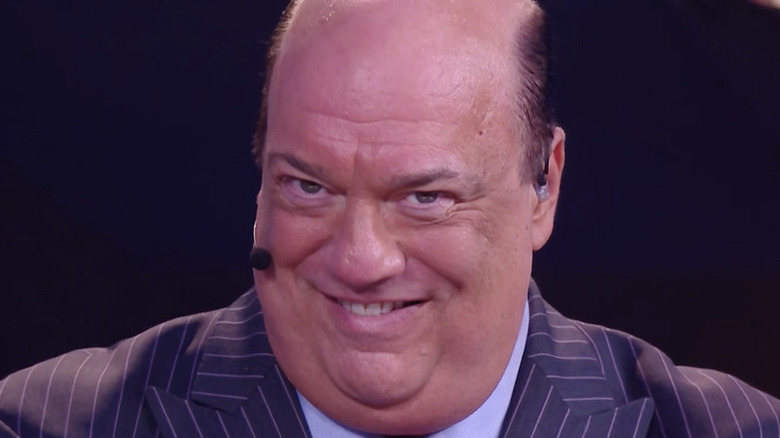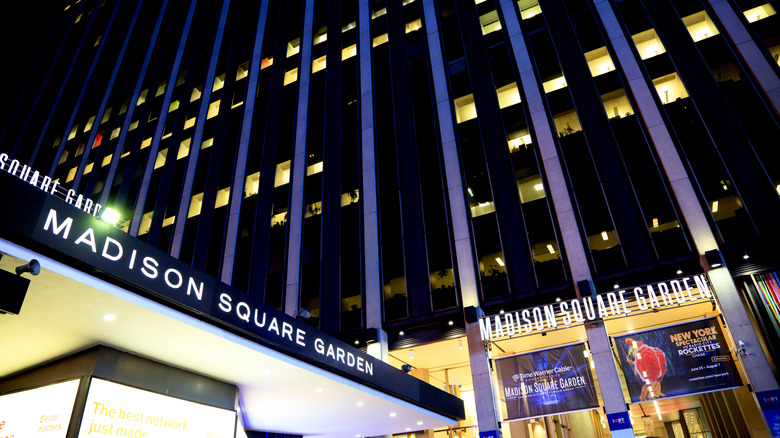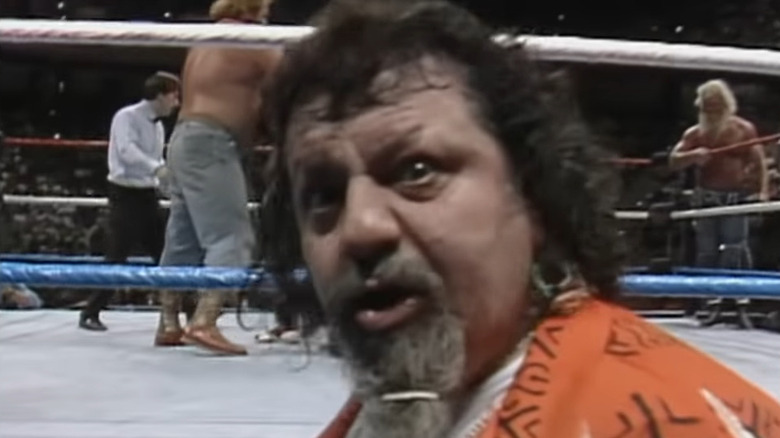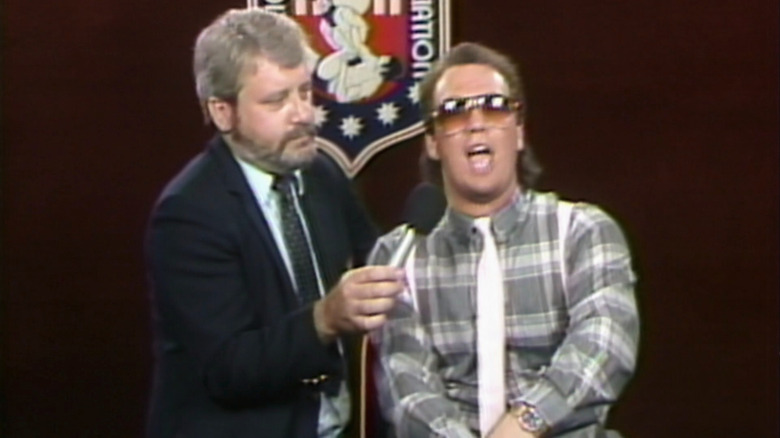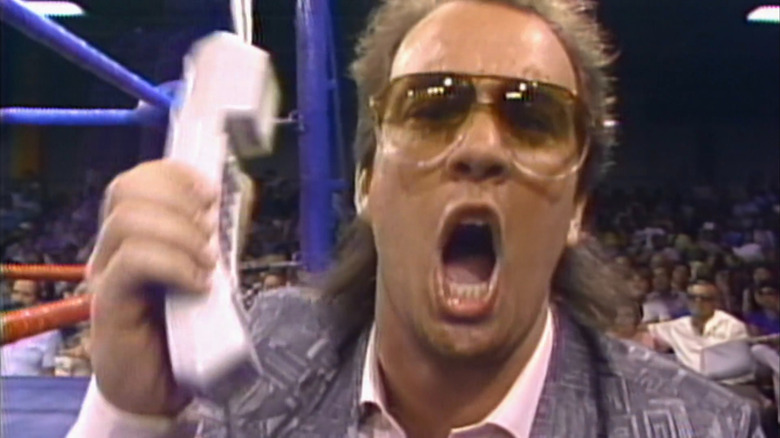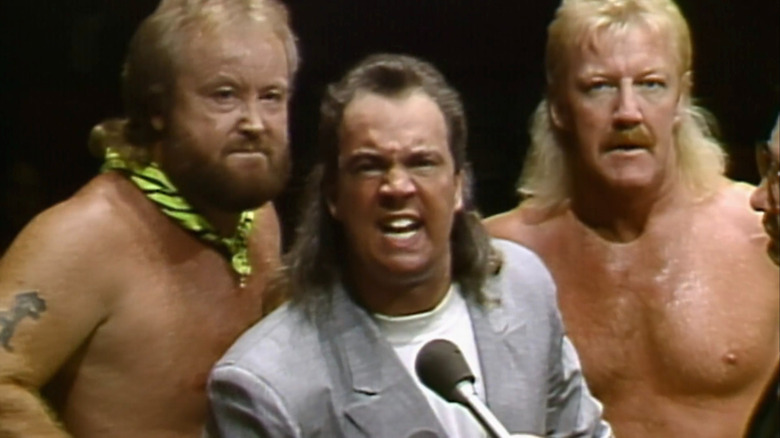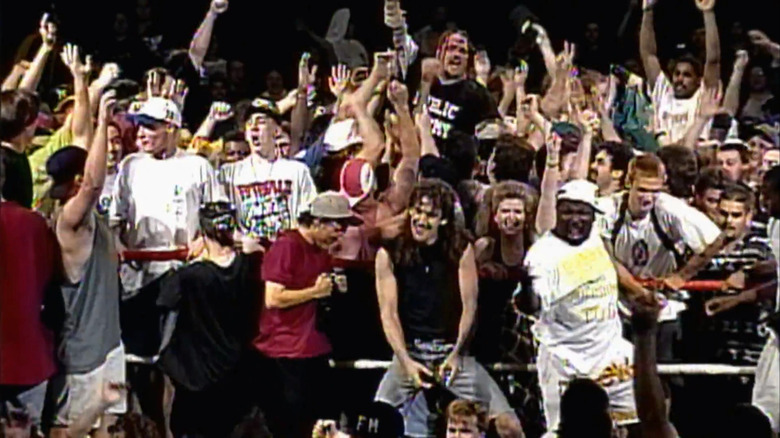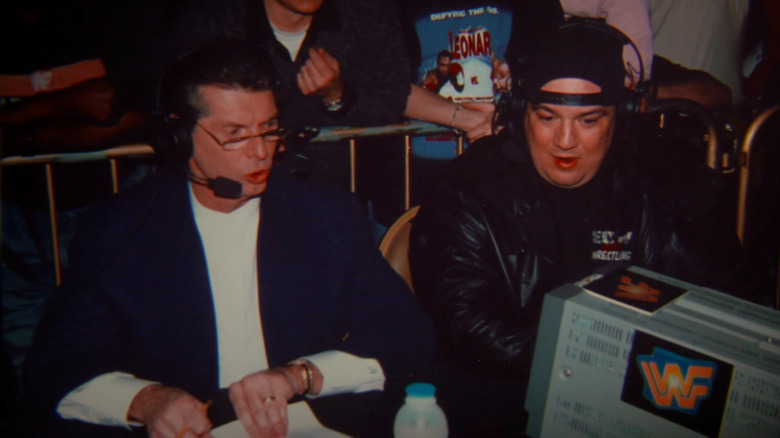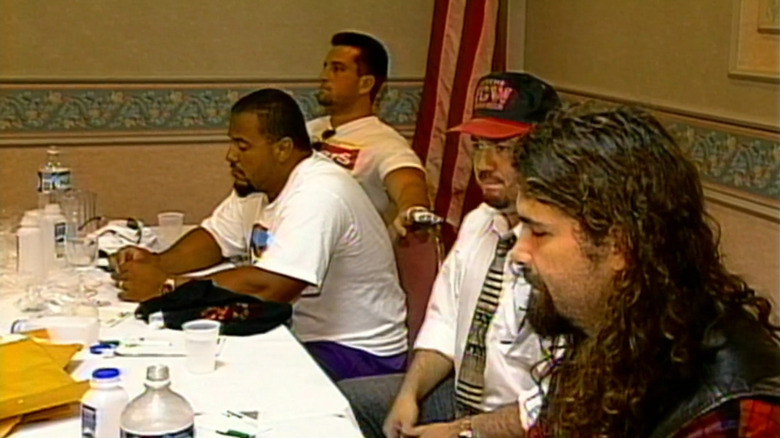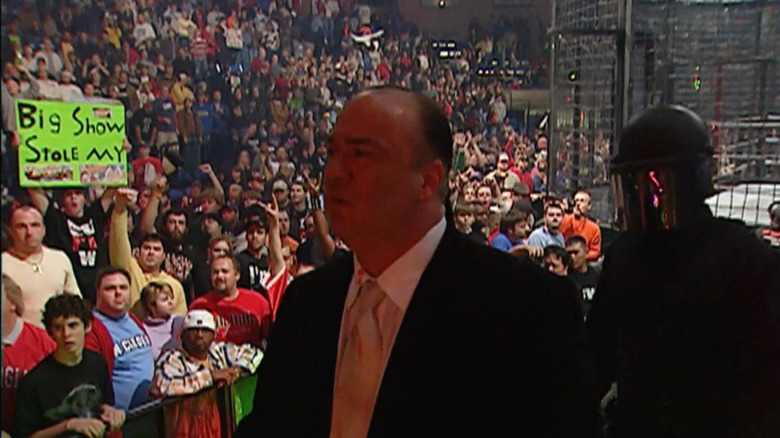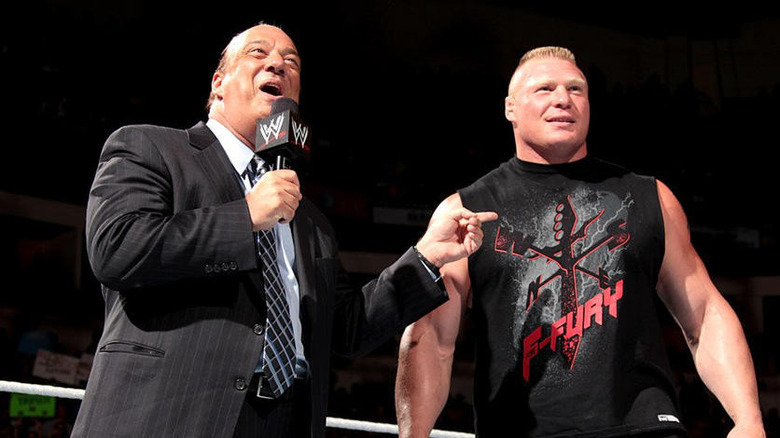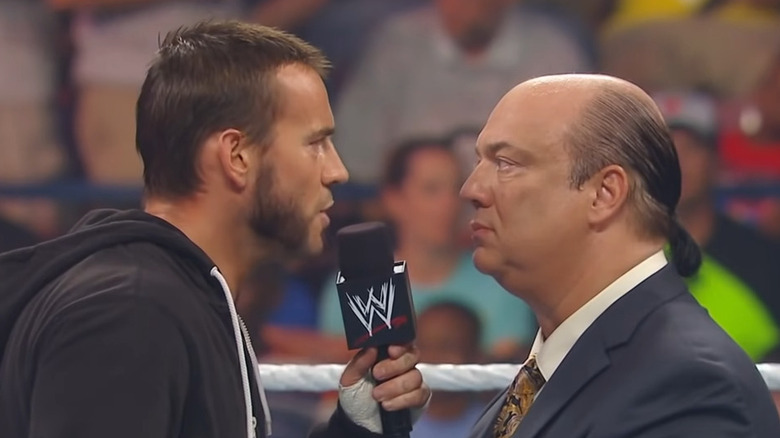Facts About Paul Heyman Only Hardcore Fans Will Know
"Ladies and gentlemen, my name is Paul Heyman!" Whenever those seven words hit the ears of wrestling fans, they know that they're in for something special. From a very young age, Paul Heyman never wanted to be one of the crowd and craved a career in the world of professional wrestling. Heyman was instilled with an unwavering hustle by his parents, themselves two tenacious human beings.
This attitude, and a propensity for stretching the truth if it behooved him, helped Heyman get a foothold in wrestling. From hustling his way backstage at Madison Square Garden to revolutionizing wrestling with ECW, the man's career has been quite the odyssey. Having managed stars from the Midnight Express to Brock Lesnar to Roman Reigns, it's rarely ever hurt to be a "Paul Heyman Guy." Still, there are a few facts regarding Mr. Heyman that many might not be aware of and we're here to fix that. So grab a brick cell phone and a kendo stick because this is the untold truth of Paul Heyman.
He lied his way into his first gig
Paul Heyman has become well known for his unyielding hustle and his fortuitous gift of gab. In the opening segments of his WWE documentary "My Name is Paul Heyman," Heyman regaled viewers with his story of breaking into the business. From his first moments seeing pro wrestling on television, a young Heyman was immediately transfixed by the allure of the squared circle. After starting his own moderately successful wrestling fan magazine, Heyman was thirsty for bigger opportunities. Seeking to venture behind the screens of professional wrestling, Heyman pulled what would be his first big hustle. Using tertiary information regarding Vince McMahon Sr. from the Village Voice, Heyman was able to acquire a press pass for Madison Square Garden.
This allowed Heyman the opportunity to go behind the curtain and see exactly how the magic happened. These formative experiences taking pictures ringside at MSG laid the groundwork for Heyman's subsequent career in pro wrestling. Everyone needs to start somewhere, and for Paul Heyman his start was predicated on lying through his pearly white teeth.
He had many influential mentors
It always helps to learn from the best and Paul Heyman definitely received the right advice from the right people. Amongst these mentors was the likes of Captain Lou Albano, The Grand Wizard, and the legendary Classy Freddie Blassie.
All three men, even by the time Heyman entered the business, had already left impressive legacies behind. Captain Lou Albano, known for his manic promo style, was integral to the Rock 'n' Wrestling Connection — a crossover between pro wrestling and the '80s music industry. Ernie Roth AKA The Grand Wizard — a dig at Ku Klux Klan leaders — had managed the likes of Black Jack Mulligan, Stan Stasiak, and even Superstar Billy Graham. Last, but certainly not least, was Freddie Blassie, arguably one of the finest pro wrestling heels to ever live. His villainy reached such heights that while in Japan, he'd file his teeth down to points to bite and draw blood from his opponents. This act was so shocking for eastern audiences that many would suffer heart attacks, with some fans allegedly dying (via the Post And Courier).
All three men took a liking to the young Heyman, taking him under their wings. They showed him many tricks of the trade, which aided him down the line.
Heyman worked at Studio 54
As Heyman steadily built his niche within pro wrestling, he lent his services to a famous New York City nightclub: Studio 54. For those in need of an education, Studio 54 was at one time the biggest nightclub in the world (via Billboard). During the height of disco fever, Studio 54 was the place to drink heavily and dance the night away. Additionally, it was known for being frequented heavily by some of the era's biggest celebrities — including David Bowie, Elton John, Michael Jackson, and even Tina Turner.
In enters one Paul Heyman who, while working for Pro Wrestling USA, had a genius idea for some cross promotion. As explained by Heyman in his documentary, he was very good friends with Gorgeous Jimmy Garvin and inquired if he could bring him to Studio 54. Garvin, a televised pro wrestling champion, was quite the get, so Studio 54's publicist enthusiastically allowed it. This proved good timing for Heyman, as that same night the Studio 54's resident photographer was fired due to an incident at the bar. So Heyman, ever the opportunist, used this as an chance to leverage for the now empty position with Studio 54's promoter. The next day, Heyman was a photographer at the world's biggest nightclub due to another successful hustle.
He was peer pressured into managing
Back during the formative years of his career, Heyman's role extended to the world of behind the scenes work and promotion. After his rise to the role of Studio 54 producer, Heyman opted to use his new platform to aid his wrestling work as well. The result of this crossbreed was Wrestle Party '85, an epic blend of in-ring action and Studio 54's standard pageantry. This show saw an award be presented to the "Nature Boy" Ric Flair, as well as Bam Bam Bigelow's wrestling debut. Following this hit event, Bigelow got in Heyman's ear and began pushing him to jump into the role of an onscreen manager.
This story was corroborated by Heyman in his documentary and noted that he'd only do it if he could call himself Paul E. Dangerously. From there, the rest was history. Heyman slowly began managing higher profile stars as time went on and in various companies. It's almost impossible to imagine a modern wrestling landscape without Heyman's presence, so let's be thankful Bigelow saw his clear potential.
Paul Heyman was inspired by various films
Many professional wrestlers and on air personalities, such as managers, have often lifted odds and ends from various pop cultural sources. After being peer pressured into being a manager by Bam Bam Bigalow, Heyman relented but with one condition — the use of the humorous moniker of Paul E. Dangerously. This was inspired, as noted in "My Name is Paul Heyman," by Heyman sharing a resemblance to Michael Keaton's character in a film called "Johnny Dangerously." This provided a good basis for Heyman to begin building his heel persona as he began working in various promotions.
Heyman's character also had strong parallels to the character of Gordon Gekko from "Wall Street," specifically by using a similarly garish brick cell phone. Capitalizing on his inner NYC yuppie, Heyman went buck wild with the gimmick and quickly became a loathsome onscreen figure. It never hurts to draw upon popular influences, especially when they help you get over with the often unpredictable viewership of pro wrestling.
He sued WCW
Throughout his career, Heyman has never been one to remain quiet, especially when being treated in a manner he deems unfit. After becoming a manager at the encouragement of Bam Bam Bigelow, Paul took to the role like a duck to water. From the CWA to the AWA to eventually WCW, Heyman quickly became one of pro wrestling's more lauded managerial figures. His tenure managing the Original Midnight Express against the new Midnight Express, who were managed by Jim Cornette, is still a highly regarded onscreen feud.
However, not all of Heyman's time with World Championship Wrestling was peaches and cream, with some unfortunate conflicts arising in 1993. At that time, Bill Watts had become the new head of WCW and Heyman went to confer with his new boss. As Heyman alleged to Slam Wrestling (via prowrestling.net), Watts chose to use some rather anti-Semitic language towards Heyman during their first meeting, even asking him where his beanie (meaning his yarmulke) was. This behavior only persisted when a segment with Heyman and Medusa got the best rating numbers on the broadcast. This resulted in another alleged anti-Semitic (and sexist) outburst from Watts (via WrestleZone), which was followed by Heyman being terminated from WCW. Following the whole debacle, Heyman sued WCW for wrongful termination and ethnic discrimination with the case — per Heyman's recounting in his documentary — eventually being settled out of court.
He was influenced heavily by '90s culture
Many modern wrestling fans might take the current trend of reality influenced storylines for granted, but there was a time where it was an oddity.
The 1990s were a huge transitional period for professional wrestling, but much of the industry was slow to adapt. While pop culture was evolving through the likes of hip-hop and grunge, the likes of WWF and WCW were still producing cartoonish wrestling. This meant a lack of any grit or real life influence, hinging their ratings on corny characters and utterly played out narratives about good versus evil.
Heyman however, knew wrestling had to change with the times and opted to be at the forefront of this new era. Now at the helm, Heyman -– along with Tod Gordon — opted to take ECW (rechristened Extreme Championship Wrestling) in an entirely different direction. This desire for stylistic development is well documented in the 2005 documentary "The Rise & Fall of ECW," in which Heyman serves as a main talking head. After dissolving ECW's relationship with the NWA, Heyman began pushing a new siege of wrestling talent while also embracing the flair of the '90s. This included grunge music, hip hop, high flying wrestlers and a barrage of eclectic hardcore wrestling complete with ample bloodshed.
He was getting funding for ECW from Vince McMahon
Vince McMahon's relationship with the wider world of professional wrestling has been ... complicated to say the least. The man, to this day, is viewed with both praise and justifiable scorn from many and for many reasons. From dismantling the territory system to making several problematic behind the scenes choices, the man has made many enemies. However, it would be unfair to not acknowledge his role in ECW's rise to prominence in the 1990s. Vince, ever the business man, opted to help fund Heyman's operation as it behooved him and the WWF in the long run.
Per Good Ol' Jim Ross, it was a beneficial relationship as many ECW stars would prove invaluable to WWF in the future. Also, the idea of one day owning ECW's tape library was an additional incentive for Vince to keep them alive. This support resulted in a deal between McMahon and Heyman that allowed for a little crossover action in 1997. Ahead of Barely Legal, ECW's first live pay-per-view, several ECW stars appeared under the bright lines of "Monday Night Raw." While Heyman and McMahon's business relationship was a complicated one at best, it can't be denied both arities heavily benefited from each other in various ways.
Paul Heyman's actions during ECW's final days
The last few years of Extreme Championship Wrestling's existence were definitely a tumultuous time, especially behind the scenes. Following the loss of their television deal with TNT, it became increasingly harder to keep the lights on for ECW. The bills were piling up and sadly it started to affect Heyman's standing with the boys in the locker room. One such talent who didn't receive his owed payments was The Franchise Shane Douglas, who recounted how it put a strain on his relationship with Heyman at the time. Certain stars, such as former-ECW talent Justin Credible, noted in an interview with JOB'd Out Wrestling how Heyman had paid specific talents out of pocket. Unfortunately, this didn't extend to everyone and eventually the good will towards Heyman had run dry by early 2001.
With the writing on the wall, combined with checks bouncing left and right, Heyman filed for Chapter 11 bankruptcy in April 2001. It was a sad end to a company that, despite its often subterranean budget, helped redefine pro wrestling in the '90s. This bankruptcy subsequently opened the door for Vince McMahon to buy the ECW brand in its entirety from Heyman that same year.
He left WWE in 2006 due to creative differences
Following the success of ECW's 2005 One Night Stand event, WWE saw fit to give the once-deceased brand new life on the Sci-Fi Channel. Despite a strong start, it became clear that WWE's botched facsimile of the original ECW wasn't going to be in line with the original's style. Gone was the grit and the edge, and in its place was an increasing amount of WWE's cheese ball humor. This would culminate in the straw that'd break the camel's back, creatively speaking: the infamous ECW December to Dismember 2006. To summate a very complicated backstage creative discrepancy, Vince McMahon wanted one thing while Heyman clearly wanted another. It was reported that Heyman wanted then-rising star CM Punk to win the chamber match in grand (if slightly implausible) fashion, a choice McMahon disagreed with. This led to Punk and fellow fan favorite Rob Van Dam being eliminated first, and it resulted in Bobby Lashley winning the whole thing. Much of these creative conflicts are outlined by Heyman in the special features of the DVD for his WWE sanctioned documentary.
Following a very heated argument between Heyman and McMahon, Heyman finally opted to go home — being subsequently removed from ECW TV. This resulted in Heyman remaining absent from WWE in any capacity until his return was requested in 2012 at the behest of one Brock Lesnar.
Brock Lesnar advocated for his 2012 return
When Brock made his return to WWE in the early 2010s, it raised a lot of eyebrows and for very good reason. The Beast Incarnate had been AWOL since his infamous departure following WrestleMania XX, going off to play football and subsequently dominate the octagon. Following a run in the UFC, Brock made his WWE return in 2012, F-5'ing John Cena the night after WrestleMania.
However, people were soon reminded that, for all his strengths, Brock's talking ability had never been one of them. As explained by Heyman on "Talk is Jericho," following a fairly middling promo on "Raw," Brock expressed a desire to have Heyman back by his side. Soon enough, Heyman was back on WWE programming for the first time since 2006, serving as the advocate for the Beast Incarnate. This reintroduced Heyman and his one of a kind speaking style to a whole new crop of pro wrestling fans. Since his return, Heyman has been a regular part of the WWE product for a solid decade, garnering ample acclaim. It helps to have friends in high places, especially when that friend is Brock Lesnar, who tends to get exactly what he wants.
He kept CM Punk employed
CM Punk — it's a name that conjures up equal feelings of joy and revulsion, depending on who you talk to. Whether you love or hate the Chicago bred talent or not, there's no denying his place within the pro wrestling landscape. From ROH to OVW to WWE to AEW, Punk has left a mark on many of modern wrestling's most viable companies. However, some may be unaware that his run in OVW and subsequently in WWE might not have lasted without the advocacy of one Paul Heyman.
As recounted by Heyman in his Q&A session with "Inside The Ropes," Punk wasn't clicking within WWE's developmental system the way that the higher ups had hoped. From his pedigree-like finisher, The Pepsi Plunge, to his lack of aerial moves, many behind the scenes began to sour on Punk quickly. This resulted in Punk being sent down to OVW, where Heyman was instructed to fire the promising upstart. Heyman, of course, decided against this and continued to push and develop Punk despite the pushback from management. The two quickly became friends which later resulted in an onscreen dynamic with Heyman serving as Punk's advocate during his 400+ day title reign.
